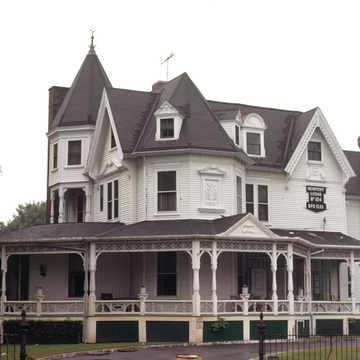This 84-foot-high arched masonry cylinder, in a one-block park between Mill and Pelham streets, has long been the subject of historical controversy. Some would trace it back to the dim mists of Norse exploration, long before Giovanni da Verrazzano's exploration of Narragansett Bay in 1524. Twentieth-century scientific scholarship, however, has conclusively demonstrated its colonial origin, partly from artifacts found at the site, partly from carbon dating of the mortar, from written documents, and from comparison with other, near-contemporary masonry structures and with Englishtype windmills. An owner of the land, Benedict Arnold (ancestor of the famous spy), erected a “stone built milne” as he states in a deed. Its wooden superstructure was no longer intact by 1740. It served as a powder magazine and a haymow before it graced many a tourist's souvenir as an emblem of Newport, and it featured in James Fenimore Cooper's The Red Rover (1828). Interesting, too, for the architectural pilgrim is the nearby monument to Commodore Matthew Galbraith Perry, by John Quincy Adams Ward with a base by Richard Morris Hunt (1868), the earliest of their many collaborations. Reliefs at the base of the stone celebrate four episodes in this Newporter's brilliant naval career, including a charming image of the commodore negotiating with Japanese to celebrate his “opening” of the country in 1856 to American commerce. The event led by the 1870s and 1880s to widespread Japanese influence in architecture and furnishings, with some key examples in Newport, soon to be seen.
Around the perimeter of Touro Park are several houses worth notice. Number 128 Mill Street, the Charles Sherman House (c. 1845), puts a Greek Revival pediment up to the street with a side entrance. In the southwest corner of the park are three other Greek Revival houses (Touro Park West and 123 and 115 Pelham Street). Completing the circuit of the park are 135 Pelham and 141 Pelham Street (probably 1870, the latter by Seth B. Stitt), carpentered extravaganzas with Victorian high jinks in the picturesque, aggressive massing of towering elements of various shapes at the rooflines with big porches below.














